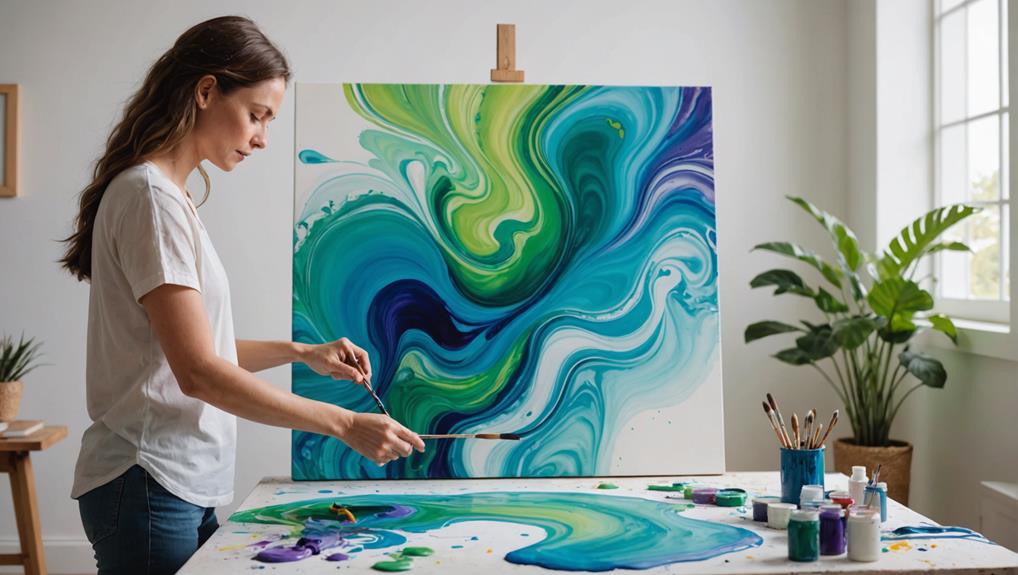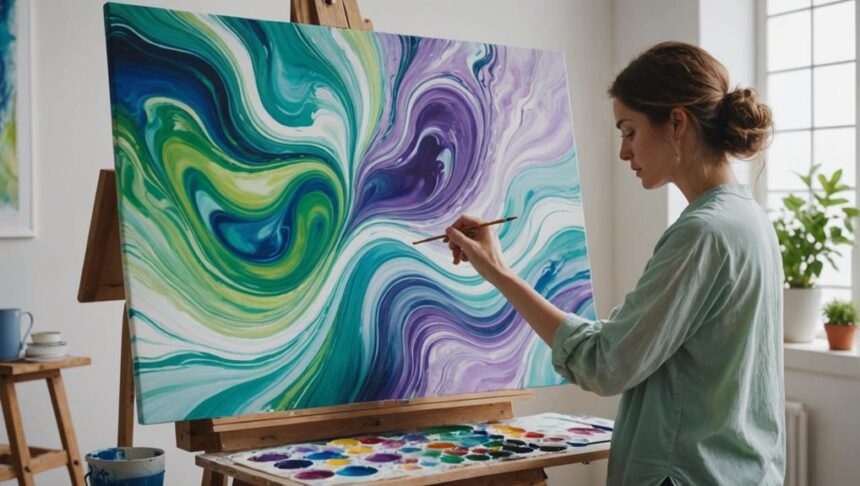Fluid art, where paint flows and dances across the canvas, is not just visually striking but also a powerful tool for mental health. It lets emotions spill out without words, offering a safe space for self-discovery and emotional release. Imagine focusing solely on swirling colors, leaving worries behind, and feeling stress melt away—engaging in fluid art can reduce cortisol levels and boost mindfulness. Plus, it’s fun and accessible to all skill levels, turning creative chaos into calming beauty. Immerse yourself in fluid art, and you’ll uncover more amazing benefits that intertwine creativity with emotional wellness.
Key Takeaways
- Fluid art provides emotional release through non-verbal self-expression.
- Engaging in fluid art fosters mindfulness and present-moment awareness.
- Creating fluid art reduces stress by lowering cortisol levels.
- Fluid art encourages creativity and spontaneous expression, enhancing emotional health.
Definition and Origins
Fluid art therapy, a recognized yet academically underappreciated form of art therapy, emerged in the late 20th century, drawing inspiration from artists like David Alfaro Siqueiros and Jackson Pollock. These artistic pioneers were known for their innovative techniques and vibrant creativity, which considerably influenced the development of fluid art.
Siqueiros, with his experimental approach to painting, and Pollock, famous for his dynamic drip paintings, laid the groundwork for this expressive art form.
Historically, fluid art evolved as artists and therapists sought new ways to merge creativity with emotional healing. The late 20th century was a time of artistic exploration, where breaking traditional boundaries was celebrated. This period saw a surge in the popularity of abstract and non-traditional art forms, creating the perfect environment for fluid art to thrive.
The combination of historical influences and the works of these pioneering artists introduced a new, engaging method for self-expression.
Fluid art therapy involves manipulating paint to create intricate patterns, allowing individuals to explore their emotions and experiences through color and movement. This process, deeply rooted in the historical influences of its artistic pioneers, has grown into a valuable tool for emotional well-being and self-discovery.
Therapeutic Benefits
Building on its historical foundations, fluid art therapy offers a multitude of therapeutic benefits that considerably contribute to emotional well-being and personal growth.
One of the most notable advantages is its capacity for emotional release. Through the process of pouring, mixing, and swirling colors, individuals find a non-verbal outlet to express complex feelings, which can considerably reduce anxiety levels.
The meditative nature of fluid art encourages mindfulness, allowing participants to focus on the present moment. This mindful engagement not only enhances emotional well-being but also fosters a sense of calm and relaxation.
The unpredictability of the medium promotes creative expression by encouraging individuals to embrace spontaneity rather than rigid outcomes, alleviating the pressure of perfectionism.
Moreover, engaging in fluid art for just 20 minutes has been shown to lower cortisol levels, the primary stress hormone, thereby decreasing stress-related symptoms.
This form of art therapy also facilitates self-discovery, enabling participants to explore their emotions and thoughts creatively. By providing a safe space for personal exploration, fluid art therapy supports emotional growth and helps individuals navigate their inner landscapes without the need for words.
Techniques and Tools
Exploring the varied techniques and tools essential for fluid art reveals a fascinating array of methods that contribute to the creation of distinctive and enchanting artworks. Fluid art techniques primarily include pouring, blowing, and tilting, which create unique patterns and textures on the canvas. Using pouring mediums can help achieve the right consistency for paints, allowing them to flow smoothly.
Acrylic paints of different paint weights can be employed to produce varied visual effects, with heavier paints sinking into lighter ones, forming intricate designs. Basic tools like canvases and optional additives such as silicone oil can enhance the creative process, allowing for spectacular special effects.
Experimentation with vertical surfaces can lead to drip painting techniques, adding an additional layer of complexity and originality to fluid art pieces. Techniques like swiping and dragging tools also allow artists to manipulate the paint further, offering endless possibilities for creativity.
| Technique | Description |
|---|---|
| Pouring | Pouring paint directly onto canvas |
| Blowing | Using air to move paint |
| Tilting | Tilting canvas to spread paint |
| Swiping/Dragging | Using tools to manipulate paint |
Accessibility and Community
Fluid art is not just for seasoned artists; it’s an inclusive activity where anyone, regardless of skill level, can join in and have fun.
With classes available both in person and online, there’s a welcoming space for everyone to create and connect.
These shared creative experiences foster a strong sense of community, making it easy to bond, collaborate, and support each other while exploring new artistic techniques together.
Inclusive Art Classes
Inclusive art classes are designed to be accessible to individuals of all skill levels, ensuring that no prior artistic experience is necessary for participation. These classes create an environment where everyone can engage in artistic expression and initiate creative exploration.
By focusing on accessibility, fluid art workshops enable participants to enjoy the process of creating art without the pressure of producing a perfect final product.
Key features of inclusive fluid art classes include:
- Welcoming Environment: Classes cater to various age groups, from children to seniors, making them ideal for families and friends.
- No Judgement Zone: Emphasis on process over product encourages experimentation and reduces fear of failure.
- Community Building: Workshops often foster social connections, as attendees share their creative journeys.
- Flexible Participation: Classes are designed to accommodate both individual participants and groups, such as coworkers or social clubs.
Group Collaboration Opportunities
Building on the inclusive nature of fluid art classes, group collaboration opportunities further enhance accessibility and foster a sense of community among participants.
Imagine a room filled with vibrant colors, where people from all walks of life come together for team building exercises. Whether it’s a corporate outing or a birthday party, fluid art workshops provide a unique platform for creative bonding.
Participating in fluid art with friends or family not only strengthens social relationships but also offers a creative outlet for stress relief. These classes emphasize the shared experience, allowing everyone to engage in a supportive atmosphere that nurtures personal expression and exploration.
The magic of fluid art lies in its ability to create ‘magic moments‘—those joyful instances when individuals connect through the collaborative art-making process.
In these group settings, participants often find themselves enjoying authentic interactions and building stronger connections. The communal aspect of fluid art can turn a simple painting session into an unforgettable experience.
Online Tutorial Resources
Online tutorial resources have greatly expanded access to fluid art, offering a wealth of information and community support for both beginners and experienced artists. This digital age has made it incredibly easy to immerse oneself in the world of fluid art from the comfort of your home. With tutorial platforms such as YouTube, anyone can learn various techniques and explore their creativity at their own pace.
Here are some key benefits of using online tutorial resources for fluid art:
- Accessibility: Video resources available on platforms like YouTube make it easy to start learning fluid art without any prior experience.
- Community Support: Social media communities allow artists to share their experiences, tips, and completed works, creating a supportive environment.
- Diverse Learning Materials: Websites and forums offer articles, videos, and instructional content, catering to different learning styles.
- Interactive Learning: Online classes and workshops provide live demonstrations and interactive sessions with experienced instructors.
These resources not only help people learn and improve their skills but also provide a therapeutic outlet, fostering mental well-being through creativity and community engagement.
Mindfulness and Wellbeing

Engaging in fluid art fosters mindfulness by compelling individuals to immerse themselves fully in the tactile and visual experience of color manipulation. This mindful creativity is a powerful way to distract from daily stressors and promote relaxation. As participants focus on the process of mixing and manipulating colors, they find themselves in a meditative state, which greatly enhances their emotional expression and overall well-being.
Studies have shown that just 20 minutes of fluid painting can considerably alleviate stress by reducing cortisol levels and boosting mood. The hands-on nature of the activity encourages a break from digital devices, providing a much-needed mental recharge. This creative process allows individuals to let go of perfectionism, embracing the unpredictability and experimentation inherent in fluid art.
The following table highlights key benefits:
| Mindfulness Aspect | Benefit | Impact |
|---|---|---|
| Focus on Process | Reduces stress | Lowers cortisol levels |
| Hands-on Activity | Digital detox | Mental recharge |
| Creative Freedom | Embraces imperfection | Enhances emotional health |
Social and Group Activities
Participating in fluid art activities within a group setting greatly enhances social interaction and fosters a sense of community. When people come together to create, they open up, sharing not just their artistic skills but also their thoughts and feelings. This shared experience can markedly improve team bonding and communication skills, making it a fantastic activity for both personal and professional settings.
Fluid art workshops are known to reduce stress levels, creating a relaxed environment where everyone can express their creativity freely. The act of pouring, spreading, and manipulating paint allows for authentic creative expression, breaking down barriers and encouraging vulnerability. This openness helps individuals connect on a deeper level, building a supportive community.
Here are some key benefits of participating in group fluid art activities:
- Enhanced Team Bonding: Working together on creative projects fosters stronger relationships.
- Stress Reduction: The calming nature of fluid art helps to alleviate stress.
- Authentic Expression: Participants feel free to express their true selves.
- Inclusivity: Suitable for all ages and skill levels, making it perfect for families or corporate events.
Engaging in fluid art as a group is a rewarding experience, enriching both personal and collective well-being.
Frequently Asked Questions
What Are the Benefits of Fluid Art Painting?
Fluid art painting offers significant benefits, including a creativity boost and stress relief. Its non-verbal expression aids emotional release, while the mindfulness involved in the process helps lower cortisol levels, enhancing overall mental well-being.
How Does Art Benefit Mental Health?
Engaging in art facilitates creative expression and emotional release, which can greatly enhance mental health by reducing stress, promoting mindfulness, and increasing dopamine levels, ultimately fostering emotional resilience and overall well-being.
Why Is Watercolor Good for Mental Health?
Watercolor techniques promote mindfulness practice by encouraging relaxation and reducing stress. The fluidity of watercolors allows for spontaneous creativity, which can enhance mood and provide a therapeutic outlet for expressing emotions, improving overall mental health.
How Does Art Therapy Help Emotionally?
Art therapy aids emotionally by providing a safe space for emotional expression and facilitating stress relief. It allows individuals to process feelings non-verbally, reducing anxiety and promoting mental well-being through creative engagement.
Conclusion
Fluid art, with its vibrant colors and free-flowing techniques, offers significant mental health benefits by promoting mindfulness, reducing stress, and fostering social connections.
Through its accessible nature, it encourages creativity and self-expression, providing therapeutic value and enhancing overall well-being.
Engaging in fluid art, whether individually or in groups, can lead to improved emotional health, making it a valuable practice for nurturing mental resilience and community bonds.


Leave a Reply